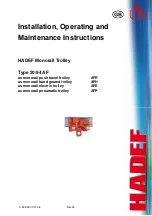
12
stored in a cool, dry location, free of any
mechanical stresses such as crushing,
pressure or traction.
IMPORTANT: If the hoist is seated on
its base when the synthetic rope is engaged
in the unit, this will result in bending
the synthetic rope resulting in possible
damage. Before use, visually inspect the
synthetic rope to make sure that the sheath
of the synthetic rope is not cut or polluted
with small stones or other debris. If
the synthetic rope is damaged, replace it
with a new Minifor™ synthetic rope and
immediately eliminate the old synthetic rope
in observance of all applicable environment
regulations.
9) Safety devices
The hoist is provided with the following safety
devices:
- A no-current brake motor
- motor equipped with a thermal probe
which blocks the motor in the event of
overheating
- Emergency stop control on control box –
Red button (see item 1, fig. 3, page A)
- Mechanical interlock, prohibiting simul -
taneous action of Up and Down controls
- high and low limit stop levers on hoist which
work with the limit stops on the Minifor™
synthetic rope
- safety latches (item 1, fig. 14 and fig. 15,
page A)
- electrical protection of hoist (see §3.1)
- Control protection fuse, in electrical unit
The emergency stop function is ensured by
pressing the red button (item 1, fig. 3, page A).
To restart the unit after an emergency stop,
the emergency stop button must be unlocked
by turning it in the direction of the arrows
marked on the button, after having ensured
that all the emergency conditions have been
eliminated.
10) Minifor™ synthetic rope
At one of its ends, the synthetic wire rope
comprises:
- a hook with safety latch mounted on a
stitched and sheathed rope loop
- a sliding protective sleeve (see item 5,
fig. 1, page 6). When there is no load on
the system, the sleeve covers the hook
to prevent damage from the environment
which may be caused by possible
impacts due to a back and forth
movement of the hook. To fasten a load,
the sleeve must be pushed upward to
uncover the hook and allow fastening of
the load.
The other end is equipped with an insertion
fitting.
To ensure safe use of the Minifor™
TR10SY hoists, they must only be used
with the Minifor™ synthetic rope specially
desi gned for these units, having a diameter
of 7 mm.
DANGER: use of a Minifor™
synthetic rope which is damaged or not suited
to the hoist represents a major safety hazard
and risk of breakdown. You must constantly
monitor the condition of the synthetic rope
and eliminate it immediately if any signs of
damage are observed on the outer layer
(sheath) causing uncovering of the internal core,
or following any contact with chemical
substances such as acids, alkaline metals,
halogens or halogen hydrocarbons.
Store the Minifor™ synthetic rope wound on
a reel or on its winder in a dry location.
Contact of the synthetic rope with products
such as oil or grease will have no impact on
the synthetic rope insofar as these products
do not contain chemical substances as
indicated in the DANGER section above.
NOTE: The service life of the
synthetic rope is limited to 400 up/down cycles.
Beyond this limit, the Minifor™ synthetic rope
must be eliminated and replaced by a new
Minifor™ synthetic rope.
GB








































